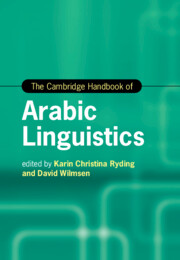Book contents
- The Cambridge Handbook of Arabic Linguistics
- Cambridge Handbooks in Language and Linguistics
- The Cambridge Handbook of Arabic Linguistics
- Copyright page
- Contents
- Figures
- Tables
- Notes on Contributors
- Acknowledgements
- Abbreviations
- Introduction
- Part I Arabic Applied Linguistics
- Part II Arabic Variation and Sociolinguistics
- 7 Diglossia, Variation, and Structural Complexity
- 8 Sociolinguistic Variation and Variation in Sociolinguistics
- 9 What Is Formal Spoken Arabic?
- 10 Arabic Dialectology
- 11 Maltese
- Part III Theoretical and Descriptive Studies
- Part IV Arabic Computational and Corpus Linguistics
- Part V Arabic Linguistics and New Media Studies
- Part VI Arabic Linguistics in Literature and Translation
- Index
- References
8 - Sociolinguistic Variation and Variation in Sociolinguistics
from Part II - Arabic Variation and Sociolinguistics
Published online by Cambridge University Press: 23 September 2021
- The Cambridge Handbook of Arabic Linguistics
- Cambridge Handbooks in Language and Linguistics
- The Cambridge Handbook of Arabic Linguistics
- Copyright page
- Contents
- Figures
- Tables
- Notes on Contributors
- Acknowledgements
- Abbreviations
- Introduction
- Part I Arabic Applied Linguistics
- Part II Arabic Variation and Sociolinguistics
- 7 Diglossia, Variation, and Structural Complexity
- 8 Sociolinguistic Variation and Variation in Sociolinguistics
- 9 What Is Formal Spoken Arabic?
- 10 Arabic Dialectology
- 11 Maltese
- Part III Theoretical and Descriptive Studies
- Part IV Arabic Computational and Corpus Linguistics
- Part V Arabic Linguistics and New Media Studies
- Part VI Arabic Linguistics in Literature and Translation
- Index
- References
Summary
Uri Horesh discusses how sociolinguistic theory and research are expressed and investigated in Arabic. He focuses on variation, stating that ‘Arabic as a natural language… exhibits and has always exhibited, a vast degree of variation’. He explores gender, class, and age as variable factors in language change, and the effects of urban/rural differences. Horesh aims to specify how research in Arabic linguistics can enrich concepts in sociolinguistics, especially as pertains to phonological processes. He examines Labov’s concept of chain shift for both vowels and consonants in Arabic dialects, and suggests how both quantitative and qualitative research findings in Arabic can contribute to sociolinguistic theory.
- Type
- Chapter
- Information
- The Cambridge Handbook of Arabic Linguistics , pp. 181 - 198Publisher: Cambridge University PressPrint publication year: 2021



